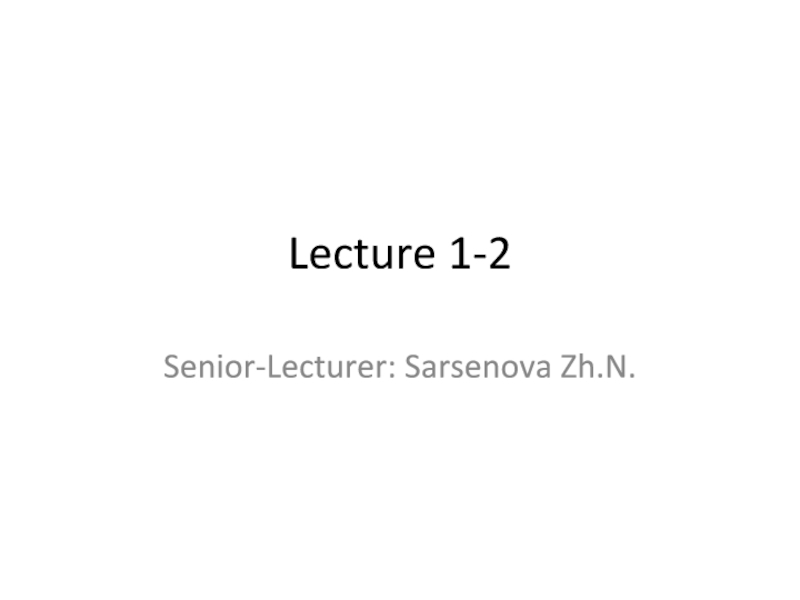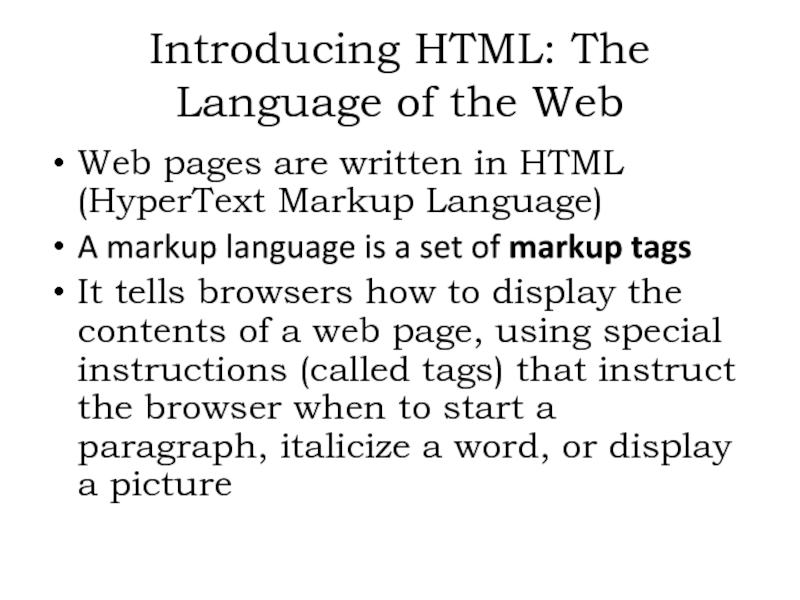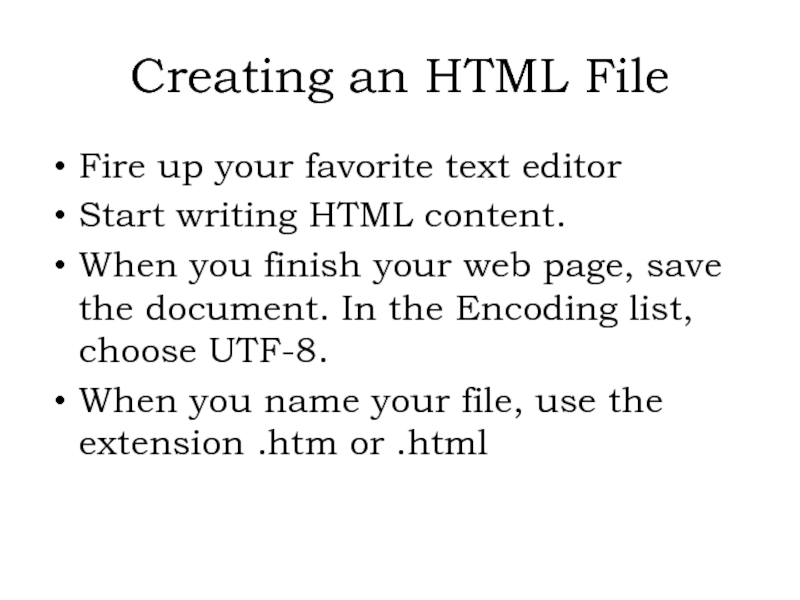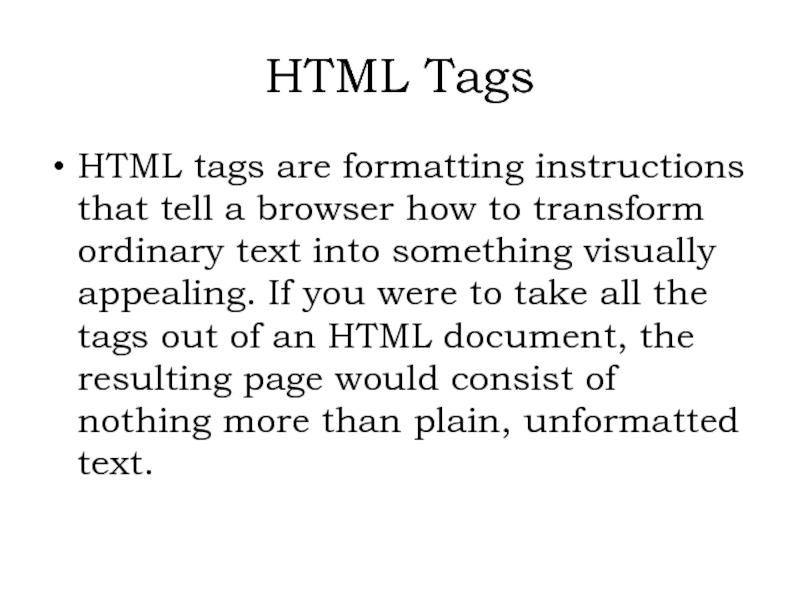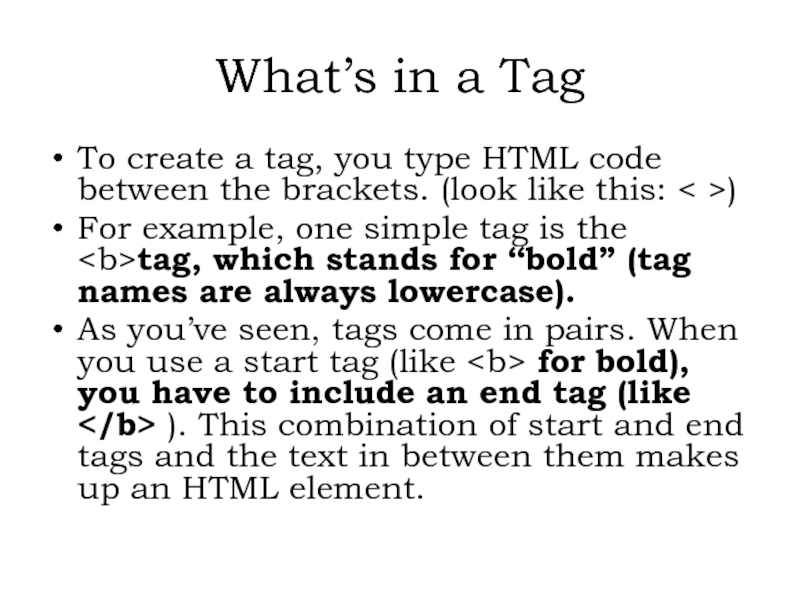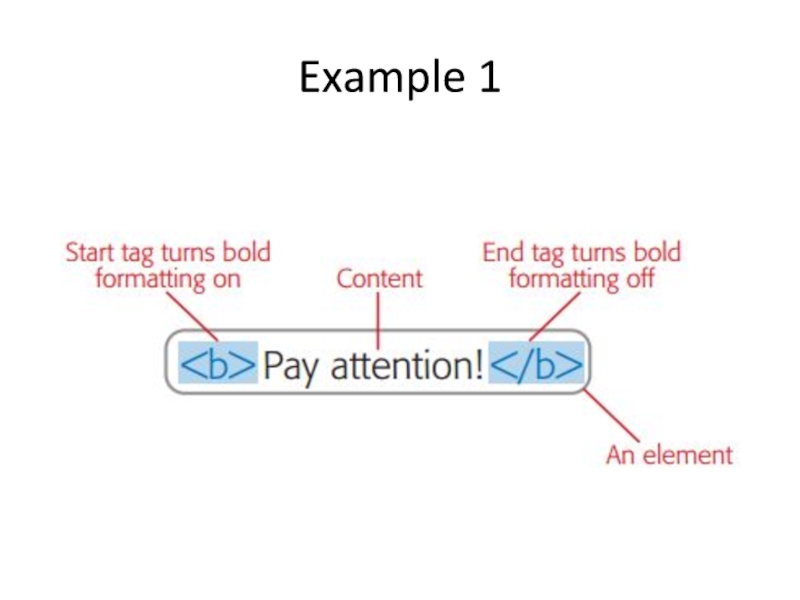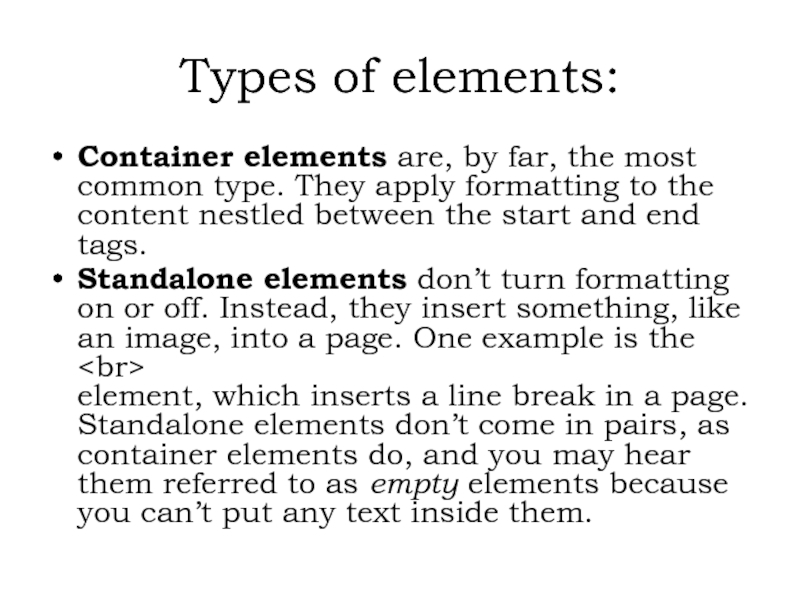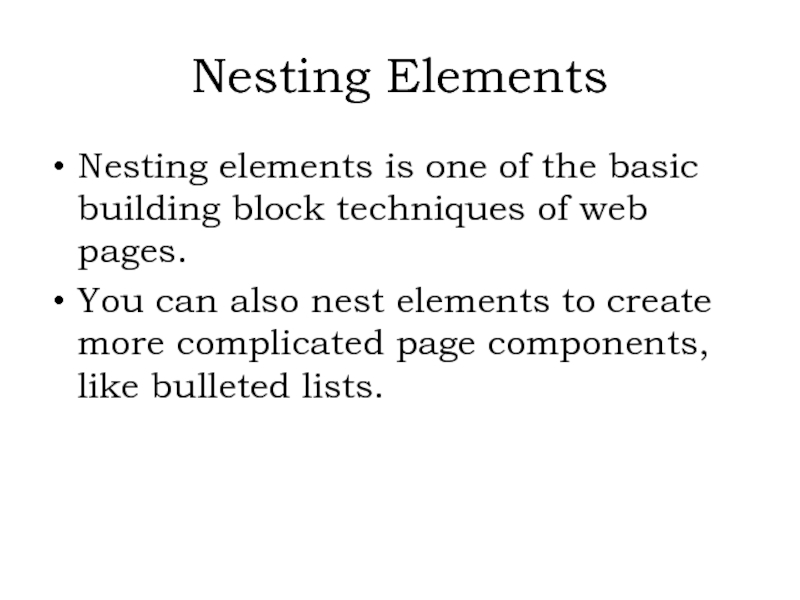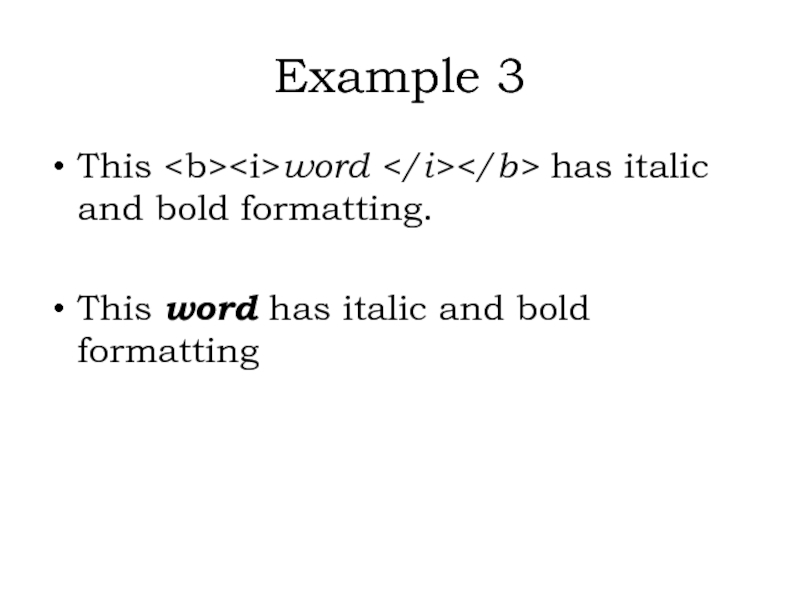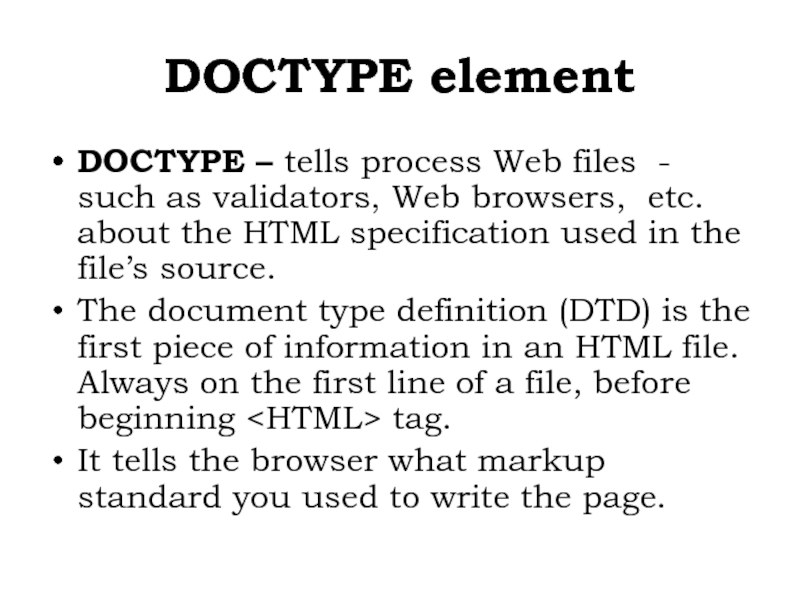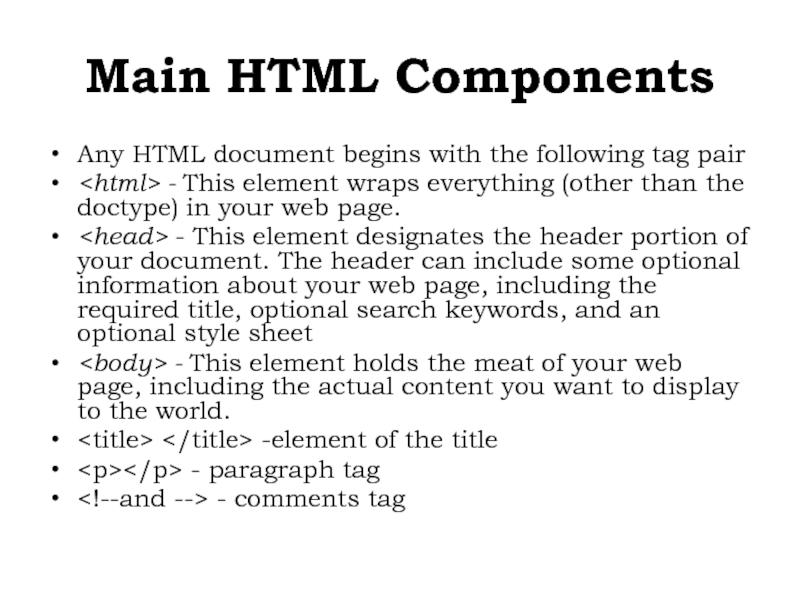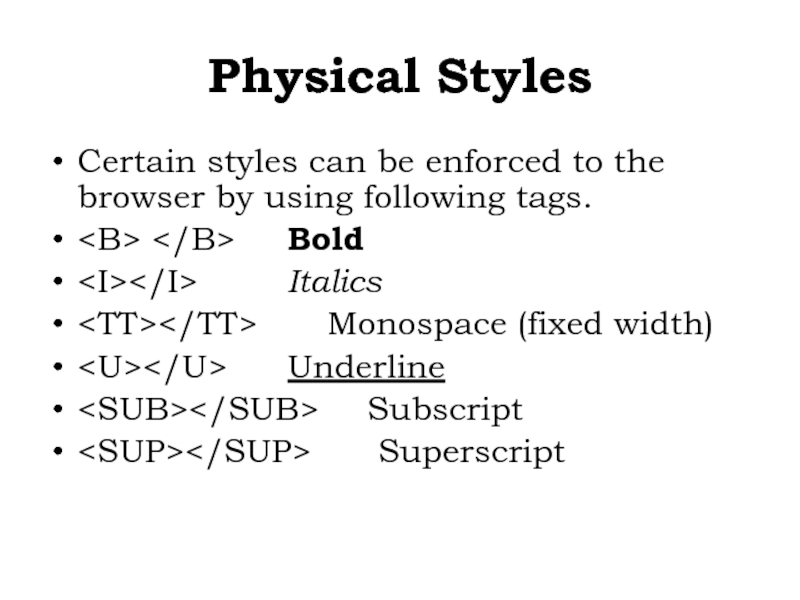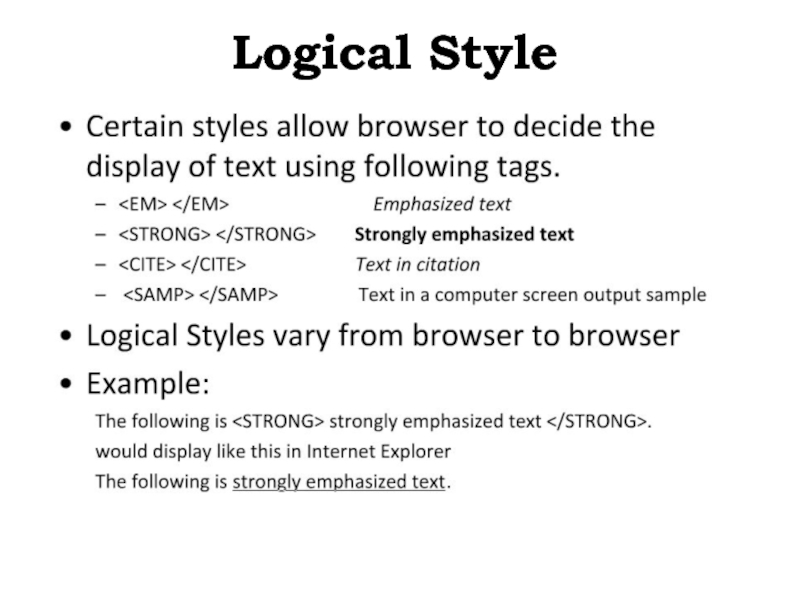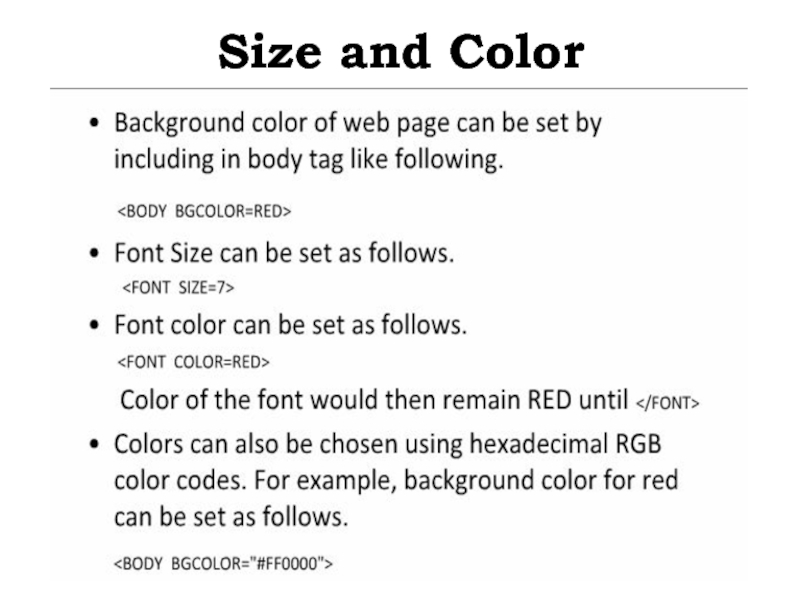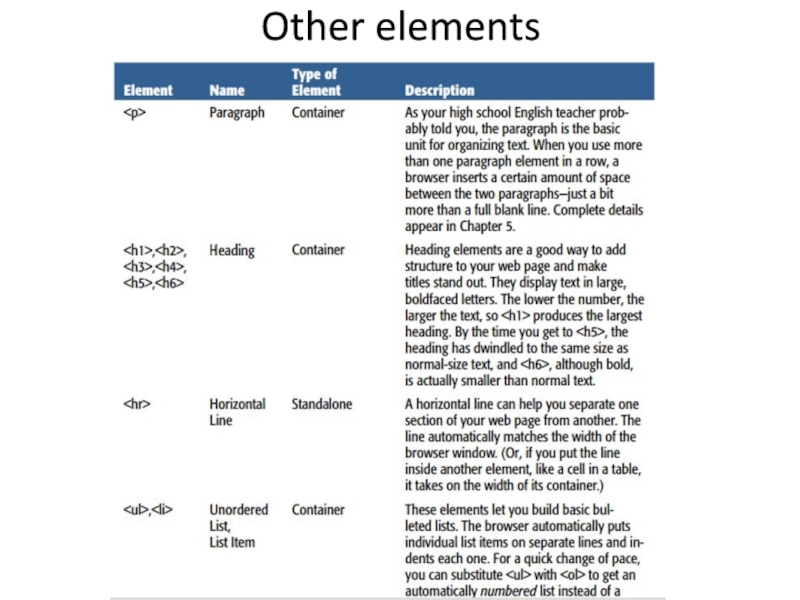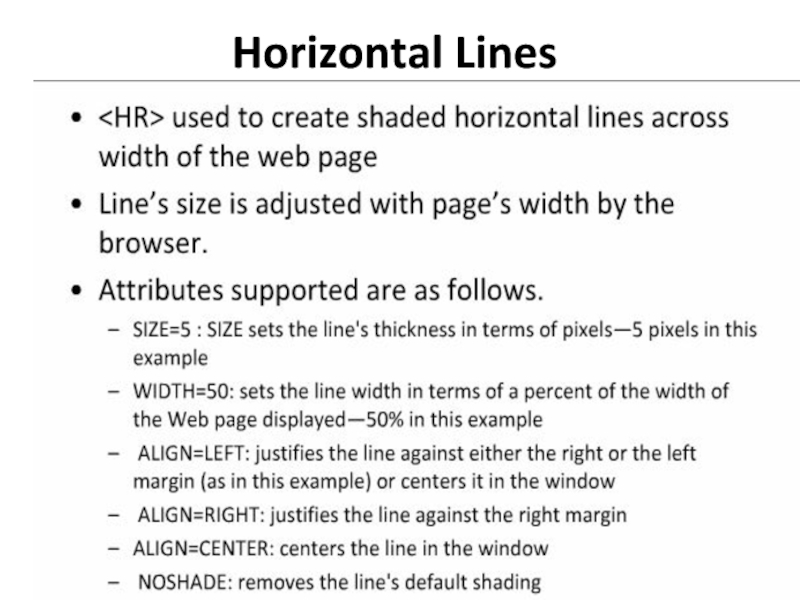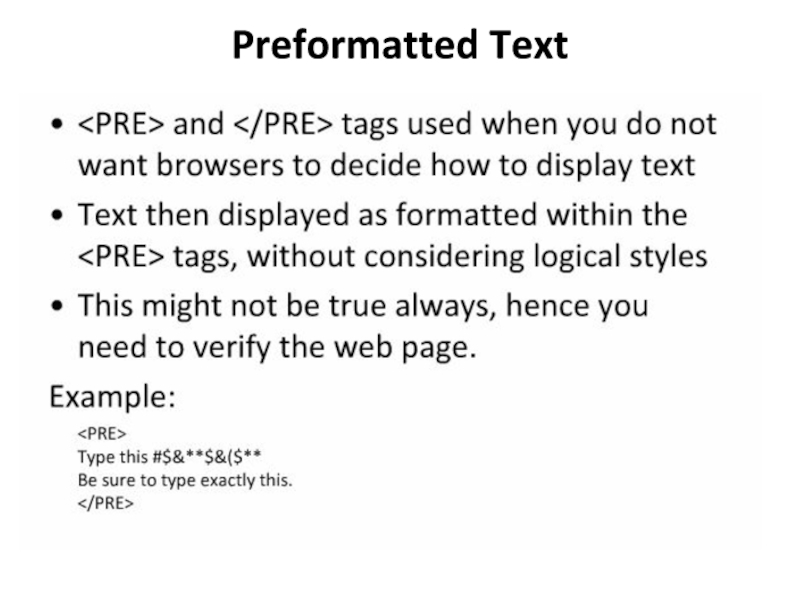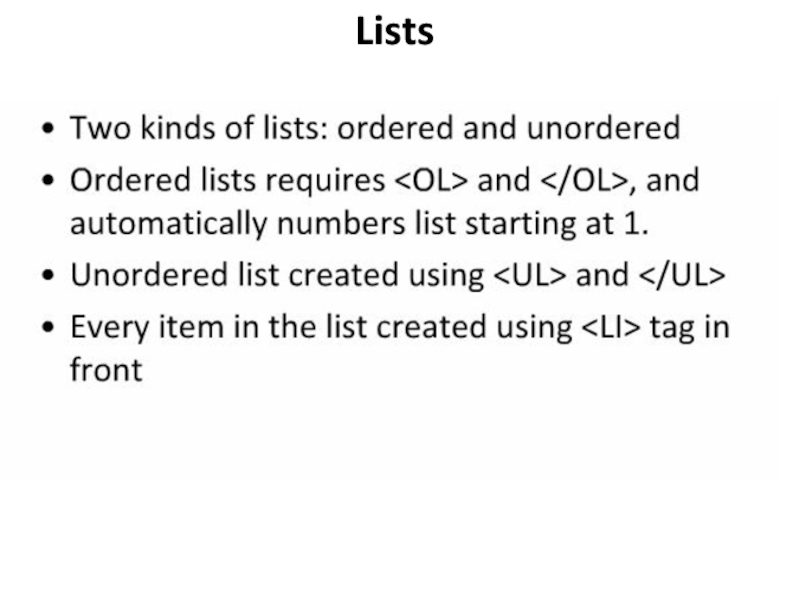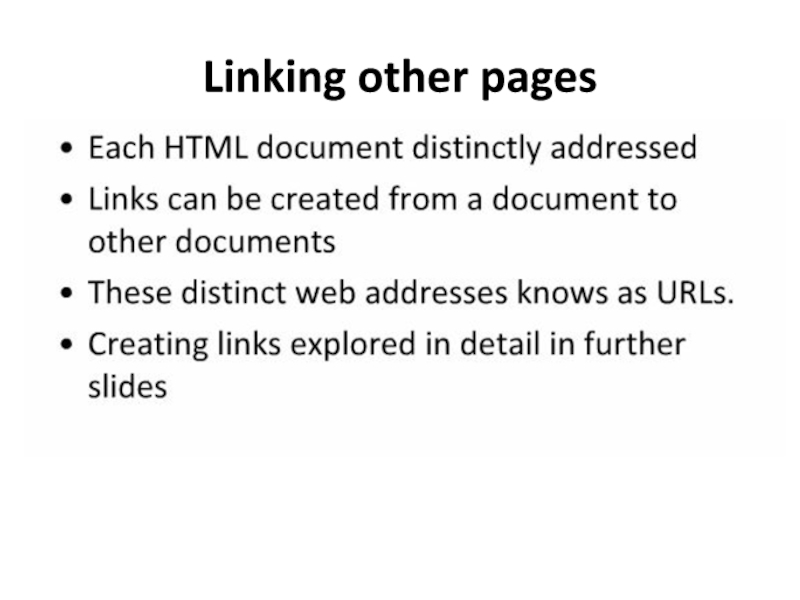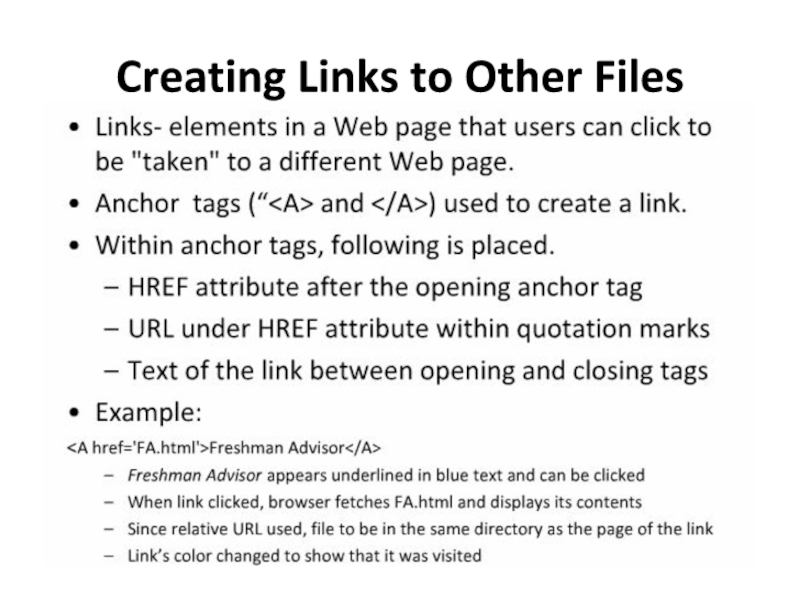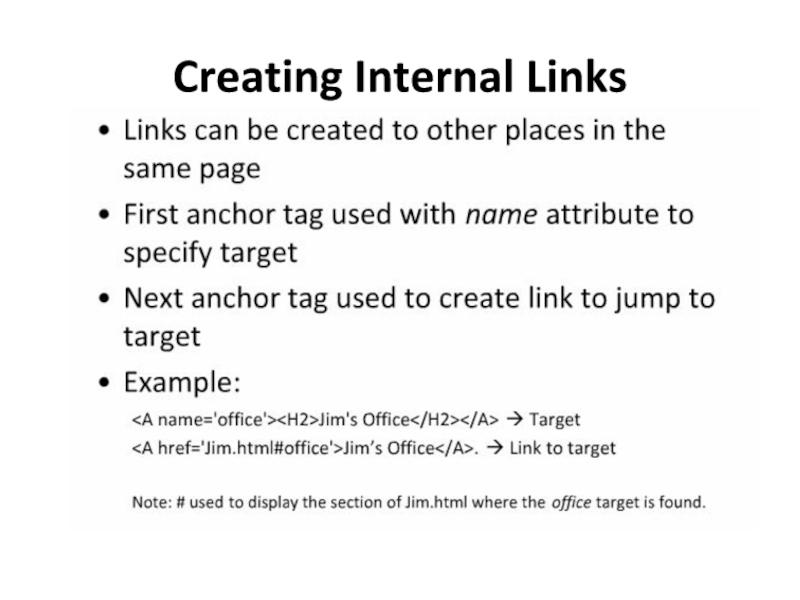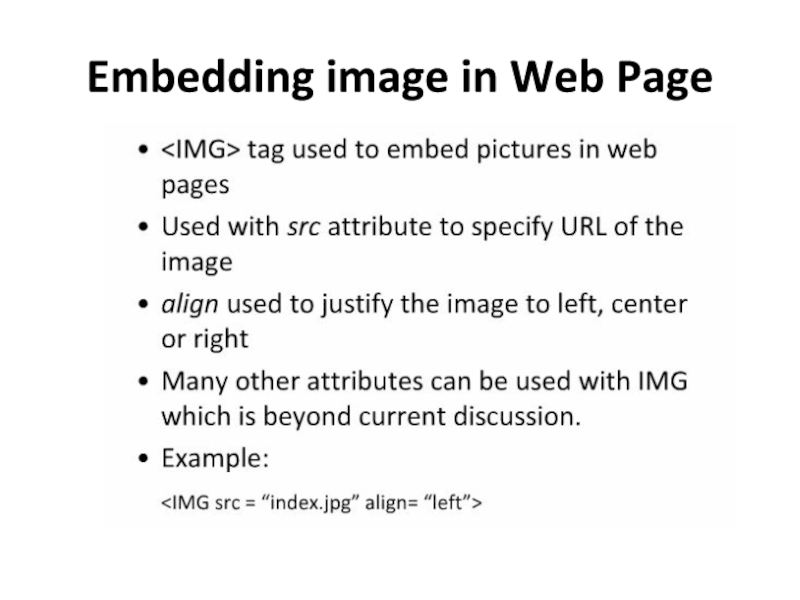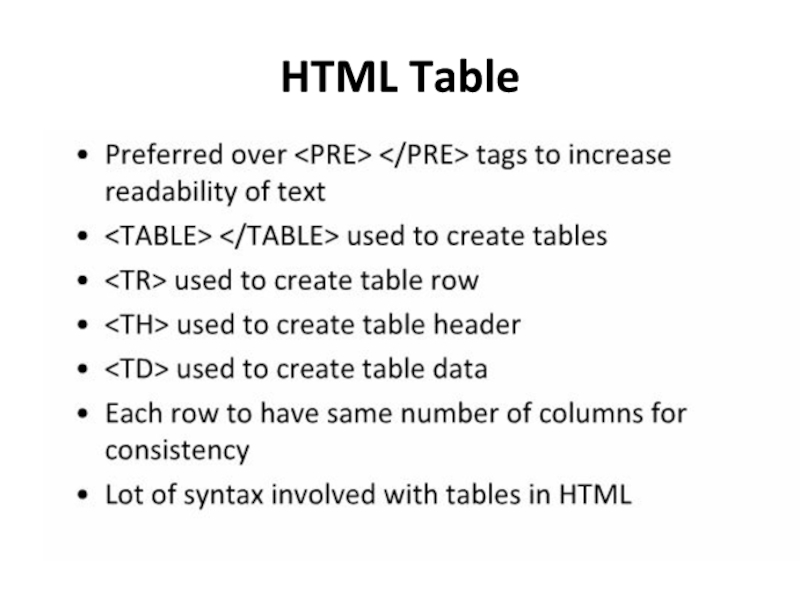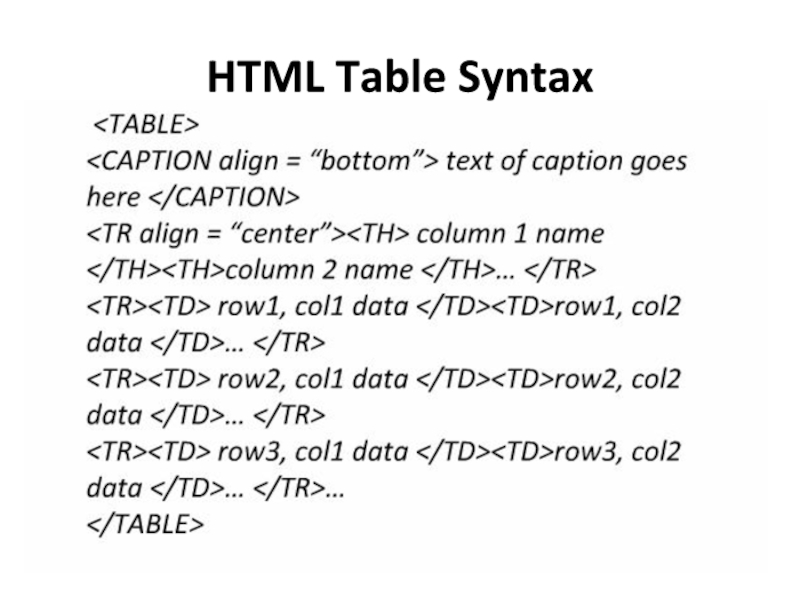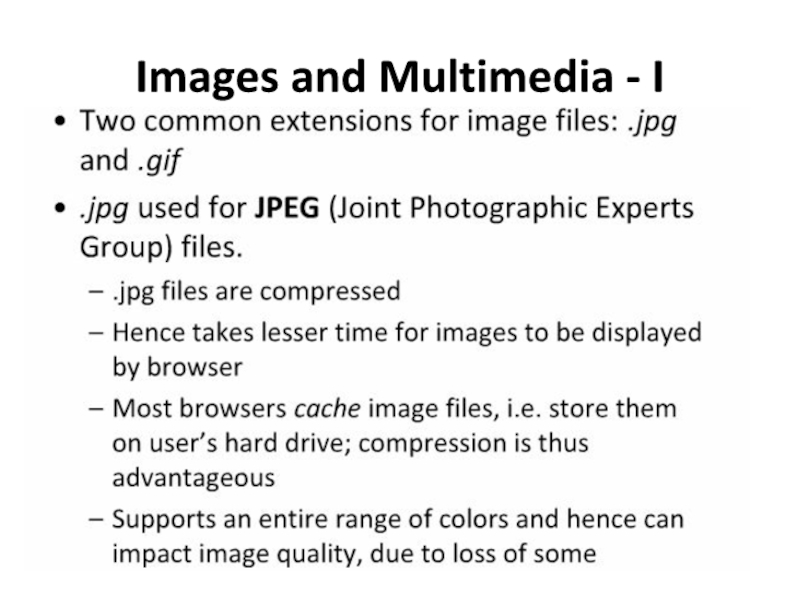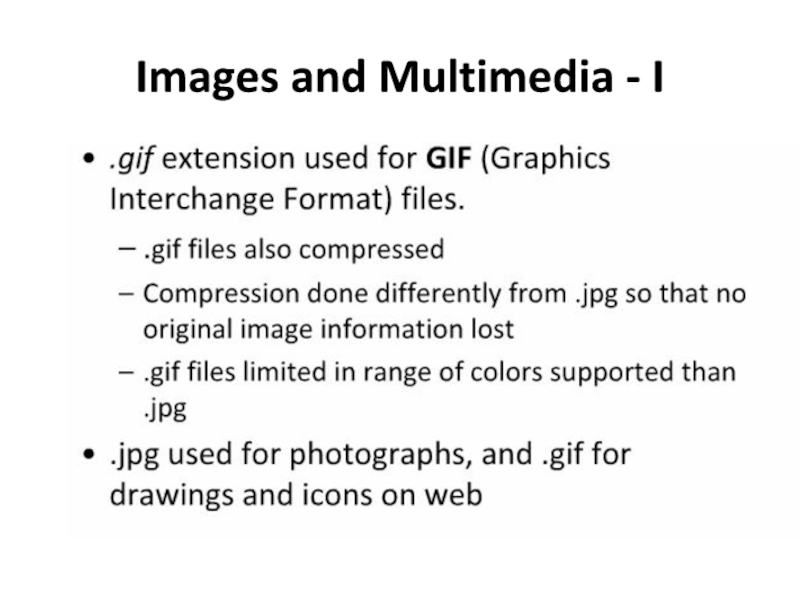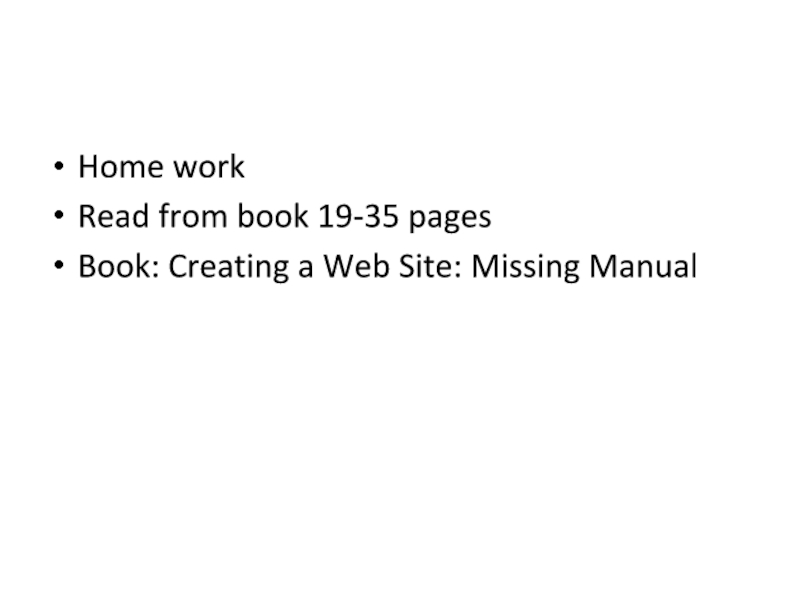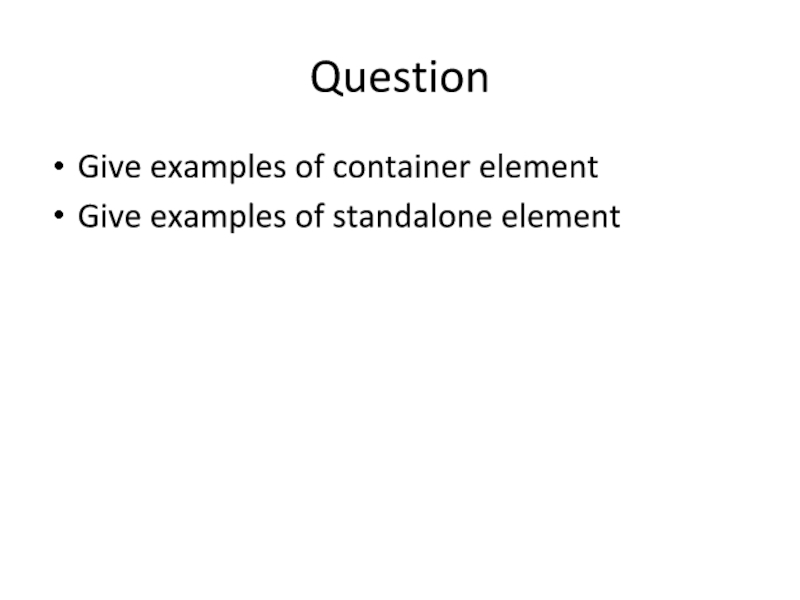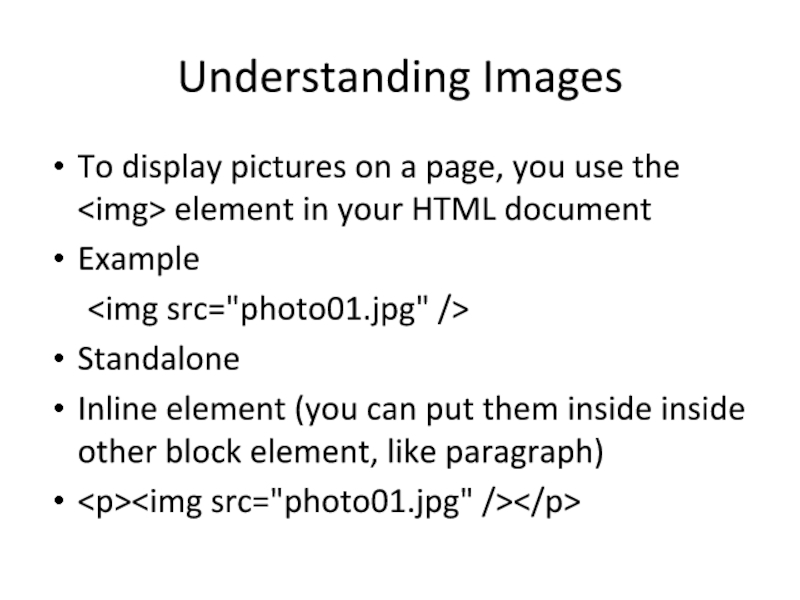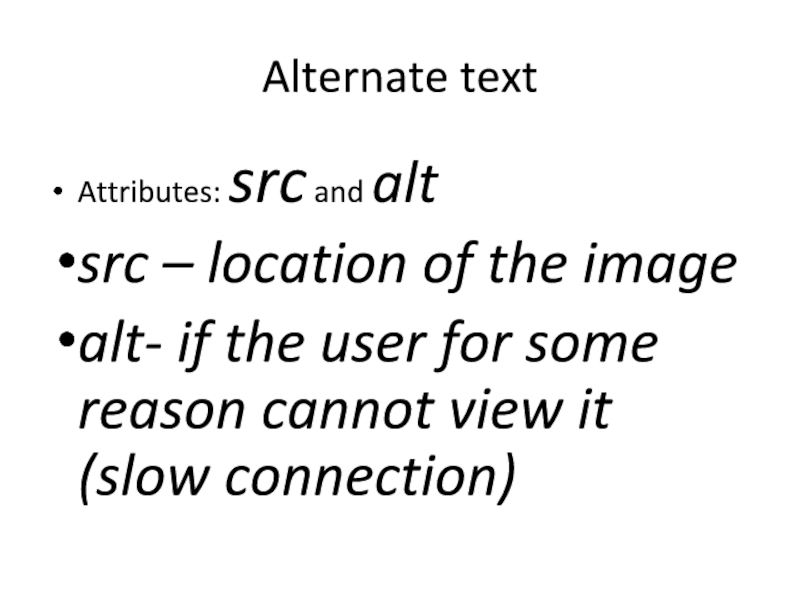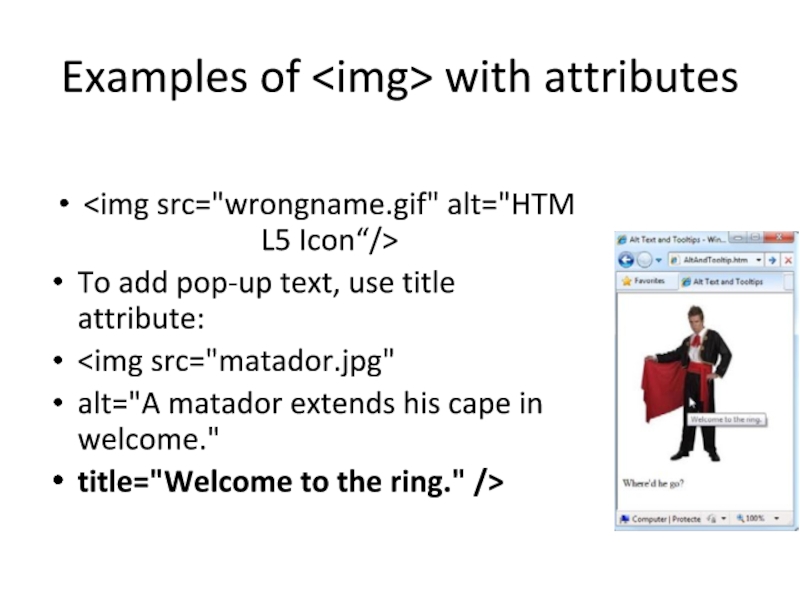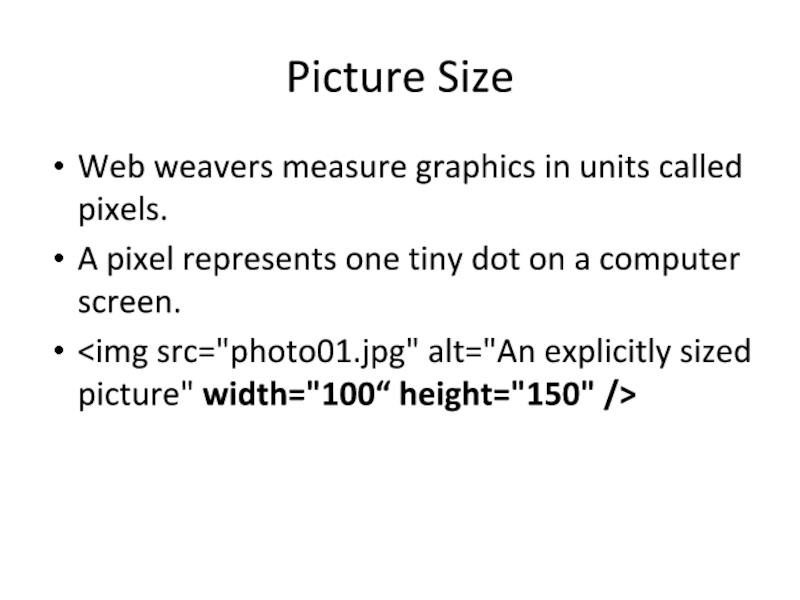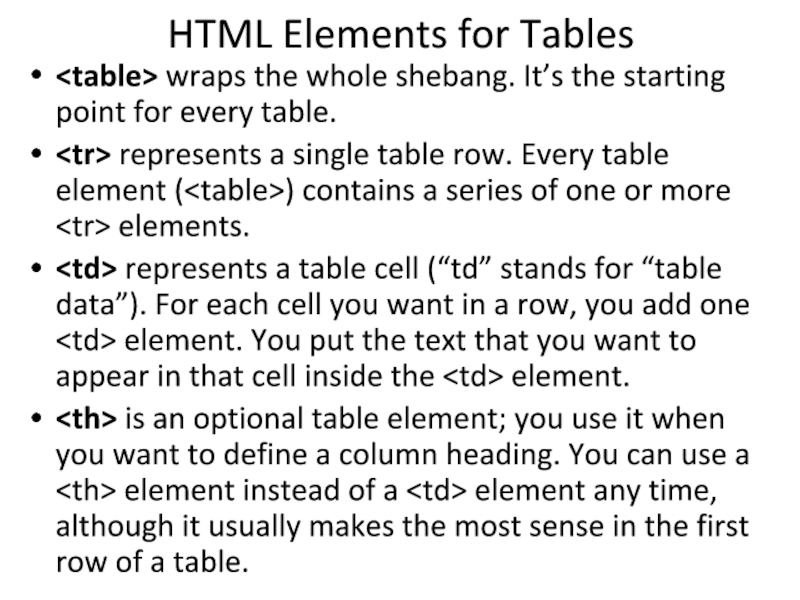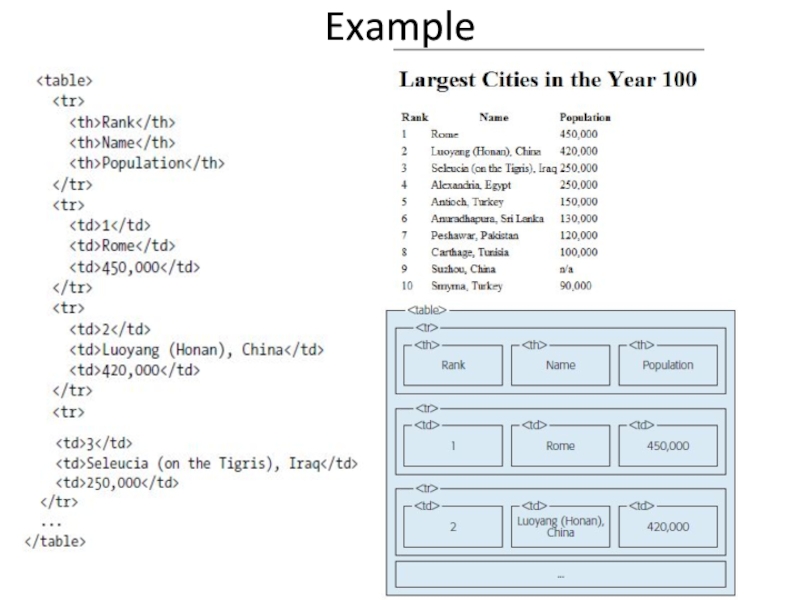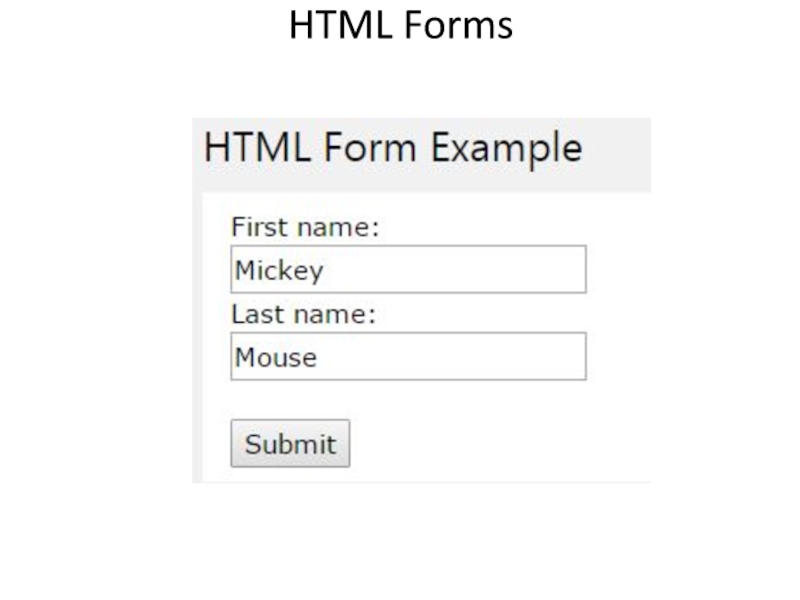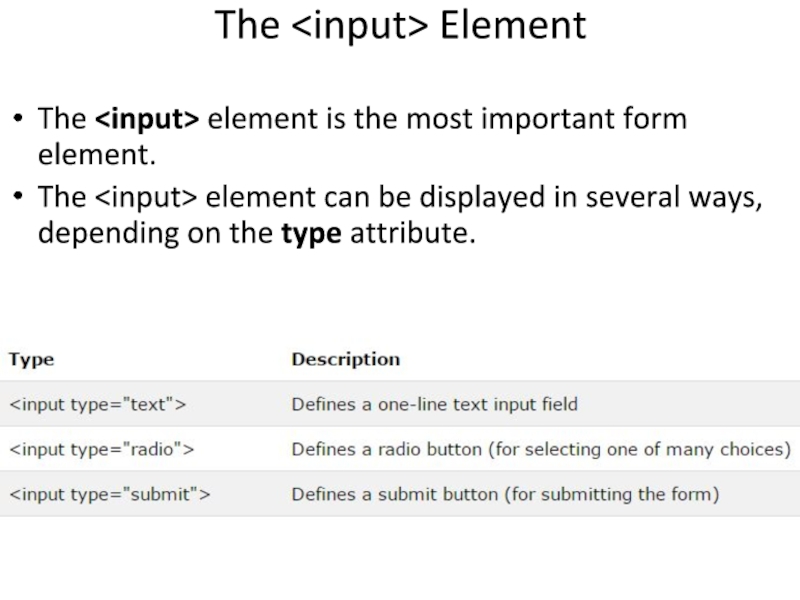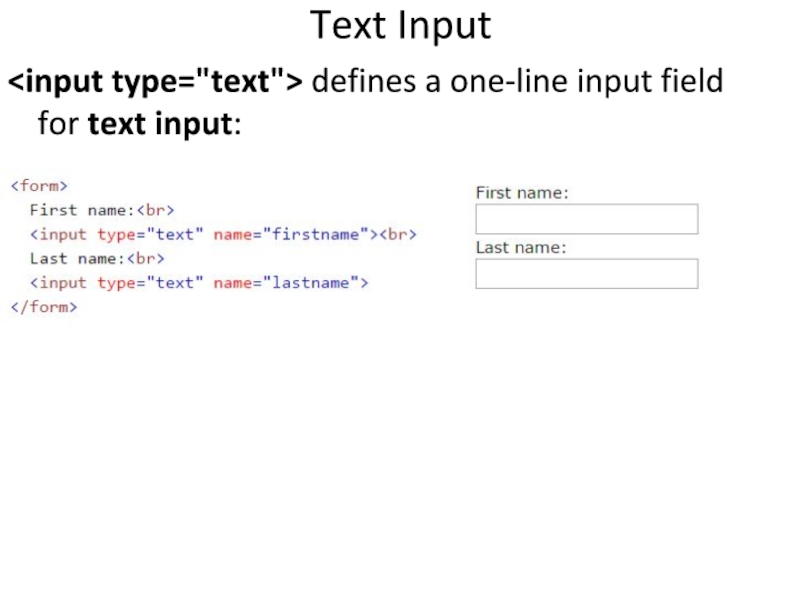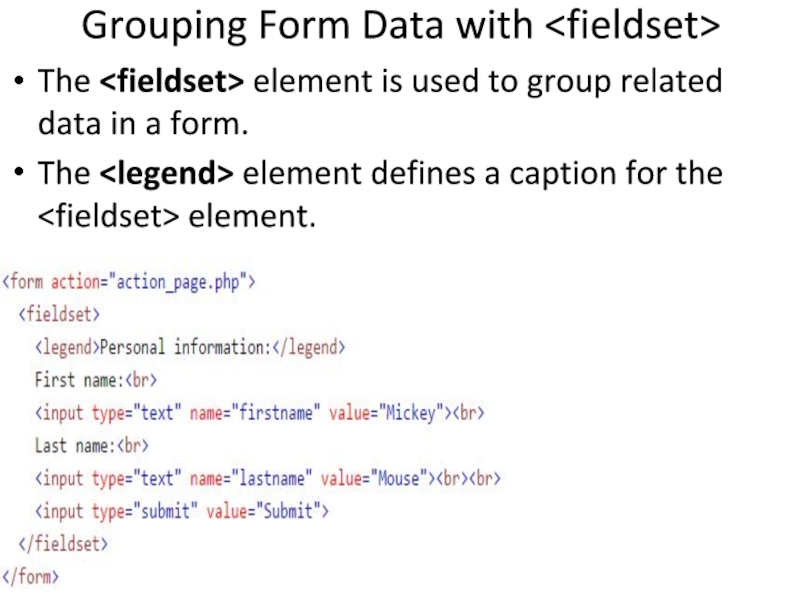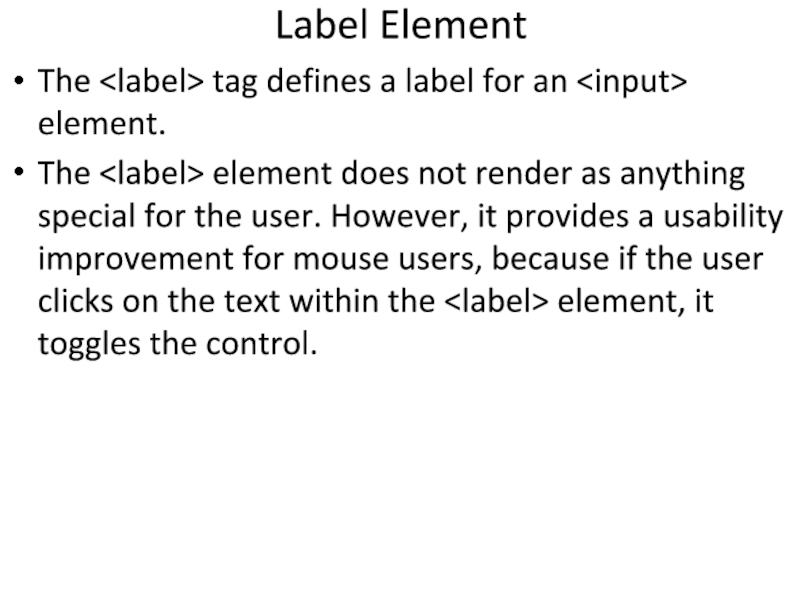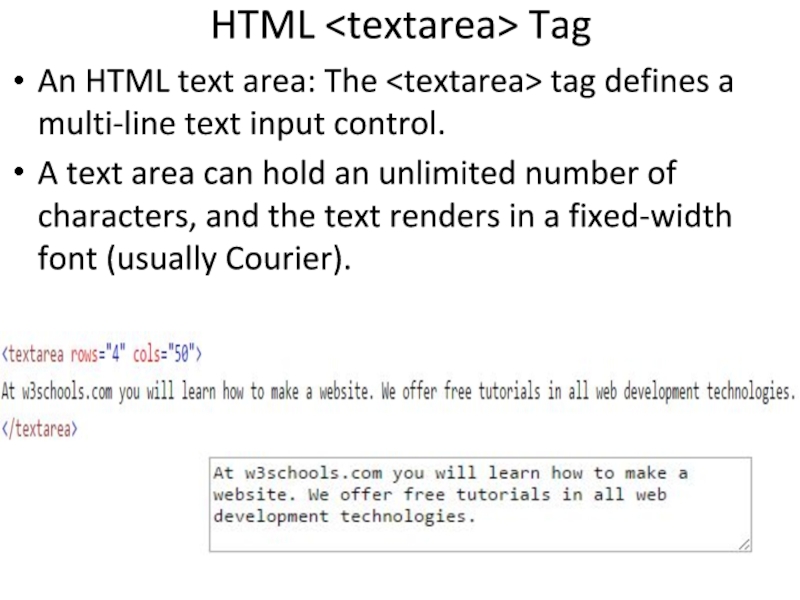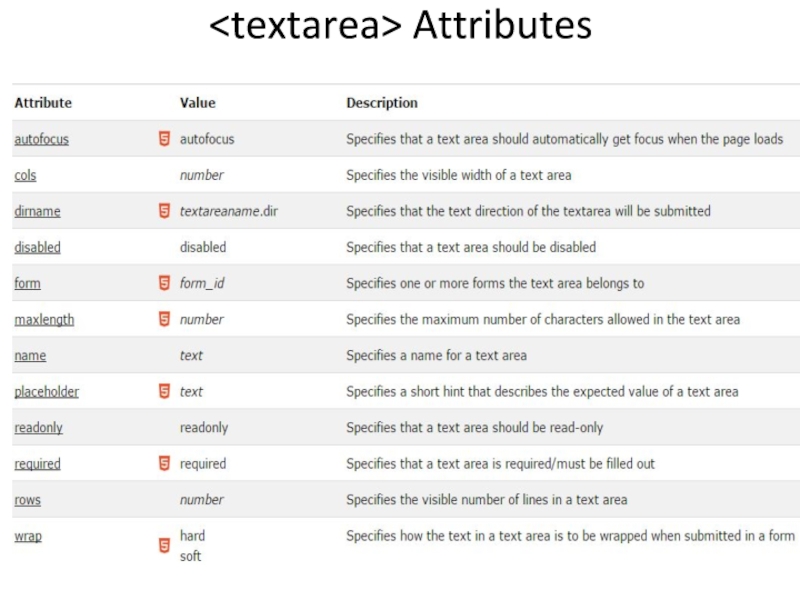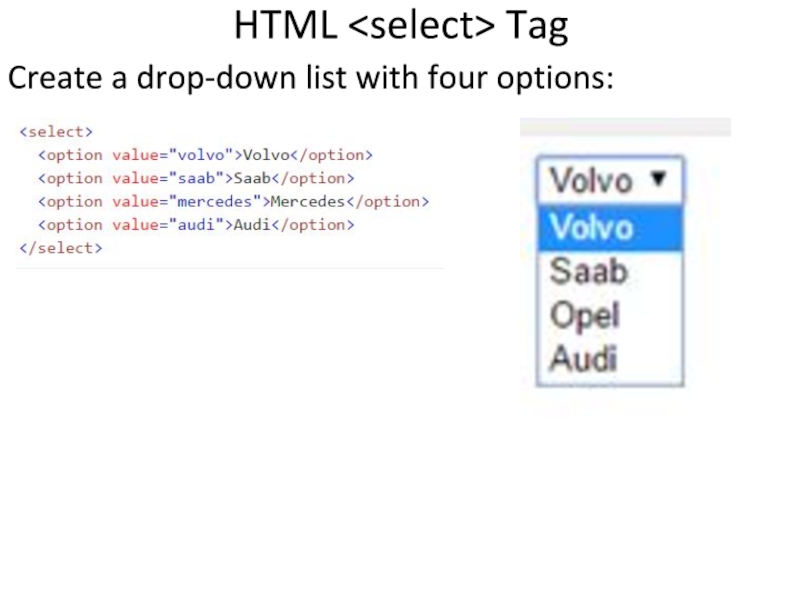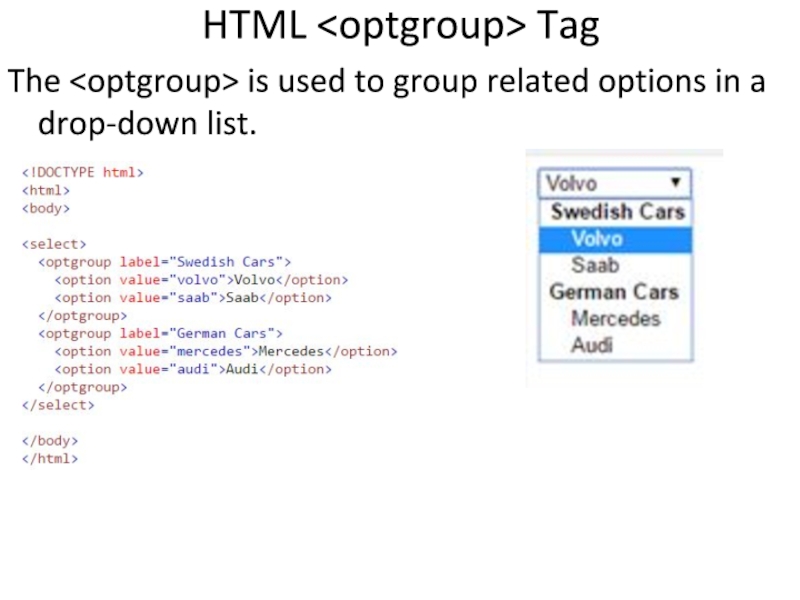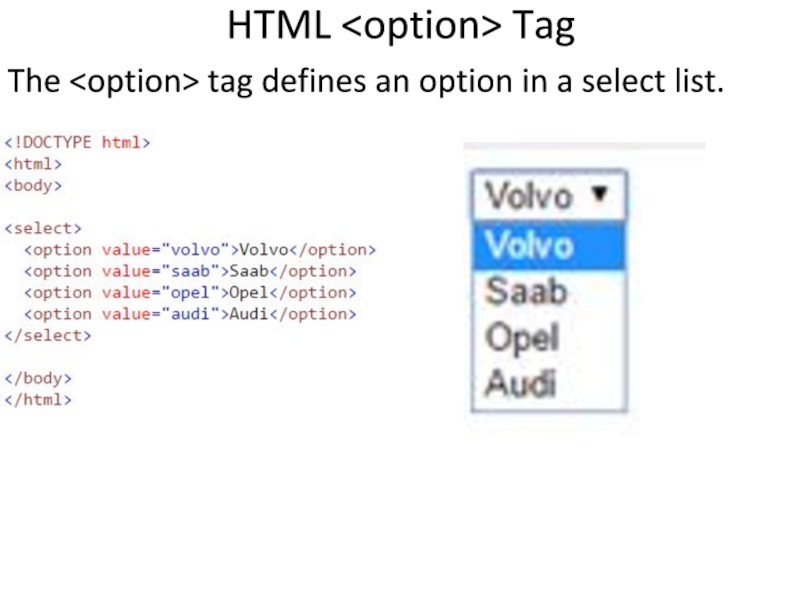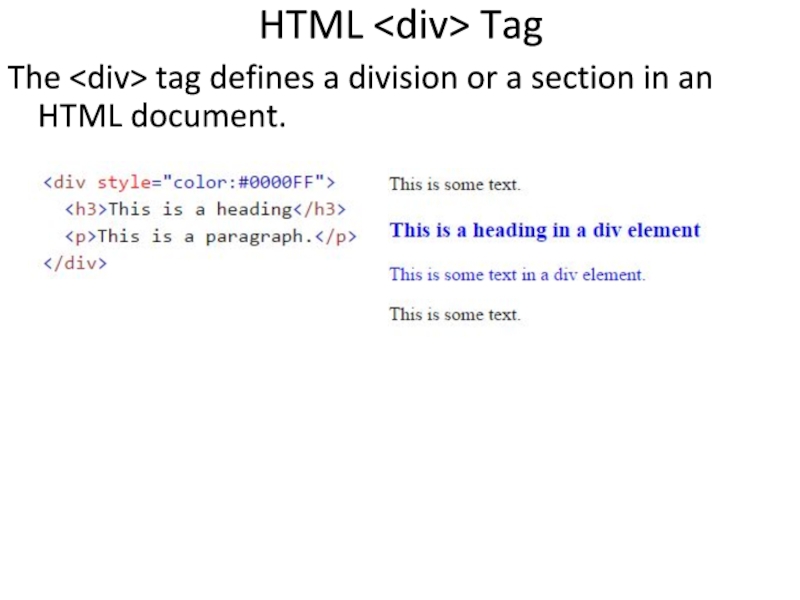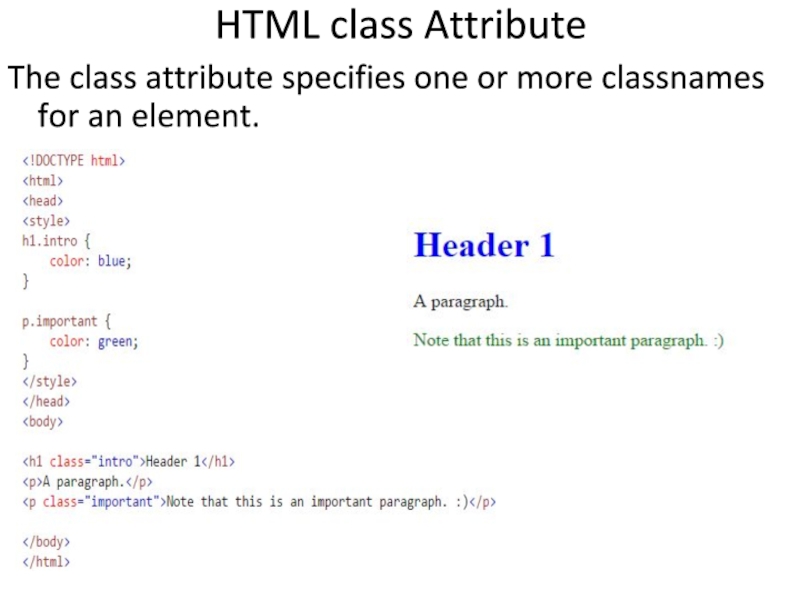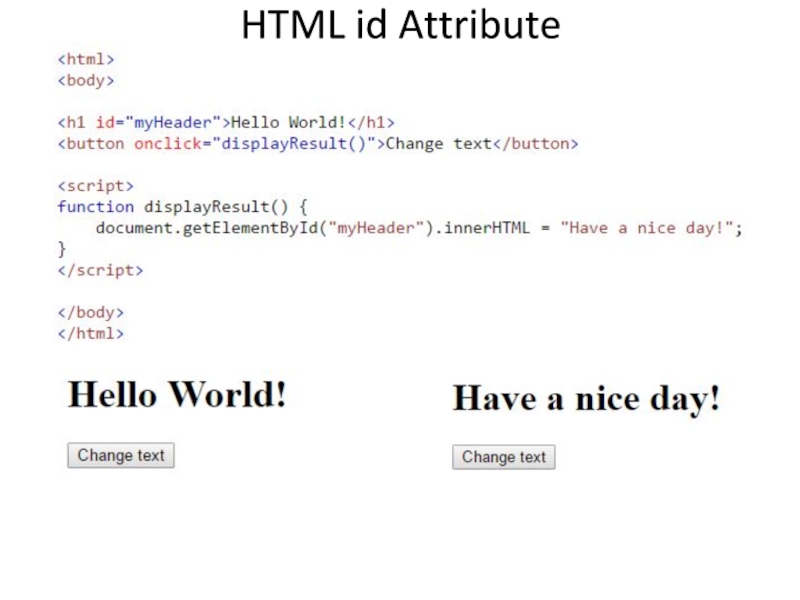- Главная
- Разное
- Дизайн
- Бизнес и предпринимательство
- Аналитика
- Образование
- Развлечения
- Красота и здоровье
- Финансы
- Государство
- Путешествия
- Спорт
- Недвижимость
- Армия
- Графика
- Культурология
- Еда и кулинария
- Лингвистика
- Английский язык
- Астрономия
- Алгебра
- Биология
- География
- Детские презентации
- Информатика
- История
- Литература
- Маркетинг
- Математика
- Медицина
- Менеджмент
- Музыка
- МХК
- Немецкий язык
- ОБЖ
- Обществознание
- Окружающий мир
- Педагогика
- Русский язык
- Технология
- Физика
- Философия
- Химия
- Шаблоны, картинки для презентаций
- Экология
- Экономика
- Юриспруденция
Introducing the World Wide Web презентация
Содержание
- 1. Introducing the World Wide Web
- 2. In 1969, the first transmission over the
- 3. Web pages are written in HTML (HyperText
- 4. Fire up your favorite text editor Start
- 5. HTML tags are formatting instructions that tell
- 6. To create a tag, you type HTML
- 7. Example 1
- 8. Container elements are, by far, the most
- 9. Nesting elements is one of the basic
- 10. This word has italic and bold formatting.
- 11. DOCTYPE – tells process Web files -
- 12. Any HTML document begins with the following
- 13. HTML Page Structure
- 14. Certain styles can be enforced to the
- 15. Logical Style
- 16. Size and Color
- 17. Other elements
- 18. Other elements
- 19. Horizontal Lines
- 20. Preformatted Text
- 21. Lists
- 22. Linking other pages
- 23. Creating Links to Other Files
- 24. Creating Internal Links
- 25. Embedding image in Web Page
- 26. HTML Table
- 27. HTML Table Syntax
- 28. Images and Multimedia - I
- 29. Images and Multimedia - I
- 30. Home work Read from book 19-35 pages Book: Creating a Web Site: Missing Manual
- 31. Question Give examples of container element Give examples of standalone element
- 32. Understanding Images To display pictures on a
- 33. Alternate text Attributes: src and alt src
- 34. Examples of with attributes
- 35. Picture Size Web weavers measure graphics in
- 36. HTML Elements for Tables wraps the
- 37. Example
- 38. HTML Forms
- 39. The Element The HTML element defines a form
- 40. The Element The element is the most
- 41. Text Input defines a one-line input field for text input:
- 42. Radio Button Input defines a radio button. Radio
- 43. The Submit Button defines a button for submitting the
- 44. Grouping Form Data with The element is
- 45. Example
- 46. Label Element The tag defines a label
- 47. HTML Forms Three radio buttons with labels:
- 48. HTML Tag An HTML text area: The tag
- 49. Attributes
- 50. HTML Tag Create a drop-down list with four options:
- 51. HTML Tag The is used to group related options in a drop-down list.
- 52. HTML Tag The tag defines an option in a select list.
- 53. HTML Tag The tag defines a division or a section in an HTML document.
- 54. HTML class Attribute The class attribute specifies one or more classnames for an element.
- 55. HTML id Attribute
- 56. HTML5 Semantic Elements A semantic element clearly describes
- 57. HTML Tag The tag defines a division or a section in an HTML document.
- 58. Semantic Elements The element defines a set
- 59. Home Work Read CHAPTER 5
Слайд 2In 1969, the first transmission over the Internet took place
Web pages
are the basic unit of a website, and every website is a collection of one or more pages
Introducing the World Wide Web
Слайд 3Web pages are written in HTML (HyperText Markup Language)
A markup language
is a set of markup tags
It tells browsers how to display the contents of a web page, using special instructions (called tags) that instruct the browser when to start a paragraph, italicize a word, or display a picture
It tells browsers how to display the contents of a web page, using special instructions (called tags) that instruct the browser when to start a paragraph, italicize a word, or display a picture
Introducing HTML: The Language of the Web
Слайд 4Fire up your favorite text editor
Start writing HTML content.
When you finish
your web page, save the document. In the Encoding list, choose UTF-8.
When you name your file, use the extension .htm or .html
When you name your file, use the extension .htm or .html
Creating an HTML File
Слайд 5HTML tags are formatting instructions that tell a browser how to
transform ordinary text into something visually appealing. If you were to take all the tags out of an HTML document, the resulting page would consist of nothing more than plain, unformatted text.
HTML Tags
Слайд 6To create a tag, you type HTML code between the brackets.
(look like this: < >)
For example, one simple tag is the tag, which stands for “bold” (tag names are always lowercase).
As you’ve seen, tags come in pairs. When you use a start tag (like for bold), you have to include an end tag (like ). This combination of start and end tags and the text in between them makes up an HTML element.
For example, one simple tag is the tag, which stands for “bold” (tag names are always lowercase).
As you’ve seen, tags come in pairs. When you use a start tag (like for bold), you have to include an end tag (like ). This combination of start and end tags and the text in between them makes up an HTML element.
What’s in a Tag
Слайд 8Container elements are, by far, the most common type. They apply
formatting to the content nestled between the start and end tags.
Standalone elements don’t turn formatting on or off. Instead, they insert something, like an image, into a page. One example is the
element, which inserts a line break in a page. Standalone elements don’t come in pairs, as container elements do, and you may hear them referred to as empty elements because you can’t put any text inside them.
Standalone elements don’t turn formatting on or off. Instead, they insert something, like an image, into a page. One example is the
element, which inserts a line break in a page. Standalone elements don’t come in pairs, as container elements do, and you may hear them referred to as empty elements because you can’t put any text inside them.
Types of elements:
Слайд 9Nesting elements is one of the basic building block techniques of
web pages.
You can also nest elements to create more complicated page components, like bulleted lists.
You can also nest elements to create more complicated page components, like bulleted lists.
Nesting Elements
Слайд 11DOCTYPE – tells process Web files - such as validators, Web
browsers, etc. about the HTML specification used in the file’s source.
The document type definition (DTD) is the first piece of information in an HTML file. Always on the first line of a file, before beginning tag.
It tells the browser what markup standard you used to write the page.
The document type definition (DTD) is the first piece of information in an HTML file. Always on the first line of a file, before beginning tag.
It tells the browser what markup standard you used to write the page.
DOCTYPE element
Слайд 12Any HTML document begins with the following tag pair
- This
element wraps everything (other than the doctype) in your web page.
- This element designates the header portion of your document. The header can include some optional information about your web page, including the required title, optional search keywords, and an optional style sheet
- This element holds the meat of your web page, including the actual content you want to display to the world.
-element of the title
- paragraph tag
- comments tag
- This element designates the header portion of your document. The header can include some optional information about your web page, including the required title, optional search keywords, and an optional style sheet
- This element holds the meat of your web page, including the actual content you want to display to the world.
- paragraph tag
- comments tag
Main HTML Components
Слайд 14Certain styles can be enforced to the browser by using following
tags.
Bold
Italics
Monospace (fixed width)
Underline
Subscript
Superscript
Bold
Italics
Monospace (fixed width)
Underline
Subscript
Superscript
Physical Styles
Слайд 32Understanding Images
To display pictures on a page, you use the
element in your HTML document
Example

Standalone
Inline element (you can put them inside inside other block element, like paragraph)
Example

Standalone
Inline element (you can put them inside inside other block element, like paragraph)

Слайд 33Alternate text
Attributes: src and alt
src – location of the image
alt- if
the user for some reason cannot view it (slow connection)
Слайд 34Examples of with attributes
attribute:
 alt="A matador extends his cape in welcome."
alt="A matador extends his cape in welcome."
title="Welcome to the ring." />
 alt="A matador extends his cape in welcome."
alt="A matador extends his cape in welcome."title="Welcome to the ring." />
Слайд 35Picture Size
Web weavers measure graphics in units called pixels.
A pixel
represents one tiny dot on a computer screen.


Слайд 36HTML Elements for Tables
wraps the whole shebang. It’s the starting
point for every table.
represents a single table row. Every table element () contains a series of one or more
| represents a table cell (“td” stands for “table data”). For each cell you want in a row, you add one | element. You put the text that you want to appear in that cell inside the | element. | is an optional table element; you use it when you want to define a column heading. You can use a | element instead of a | element any time, although it usually makes the most sense in the first row of a table.Слайд 39The Element
|
|---|
